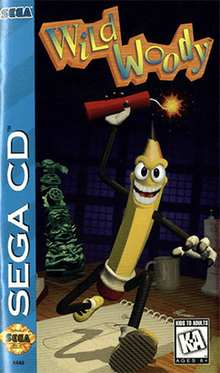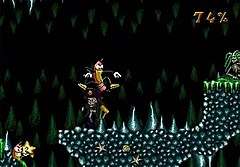Wild Woody
Wild Woody is a 1995 platform video game developed and published by Sega for the Sega CD. The game's premise is centered on the titular character, an anthropomorphic pencil who must gather the scattered segments of the totem pole that brought him to life. Woody is capable of erasing enemies and obstacles as well as creating sketches to destroy enemies or improve his navigation. The game includes 3D-rendered cutscenes featuring motion capture animation for Woody. The game's critical reception was mixed, with reviewers generally seeing Woody's abilities as interesting, but criticizing the controls.
| Wild Woody | |
|---|---|
 Cover art | |
| Developer(s) | Sega Multimedia Studio |
| Publisher(s) | Sega of America |
| Director(s) | Gordon Haberfelde Chris Shen |
| Producer(s) | Gordon Haberfelde |
| Designer(s) | Chris Shen Bruce Krueger Doug Lanford |
| Programmer(s) | Dan Hitchens David Marshall |
| Artist(s) | John Broenen Mimi Doggett |
| Composer(s) | Ron "Bumblefoot" Thal |
| Platform(s) | Sega CD |
| Release | September 1995 |
| Genre(s) | Platform |
| Mode(s) | Single-player |
Gameplay

Wild Woody is a side-scrolling platform game in which the player controls the titular character. Woody is an anthropomorphic pencil who was brought to life by the bottom segment of a miniature totem pole, and is tasked with retrieving the five scattered segments of the totem pole from the worlds they have created for themselves.[1] Woody can erase enemy characters by jumping onto them, and can erase certain walls and floors that impede his progress. Woody can also create sketches to destroy enemies or improve navigation through the levels. To use this ability, Woody must collect copies of a sketch, which will be added to Woody's personal sketchbook. The sketchbook is available in the game's pause screen, and allows the player to select a particular sketch for use. Woody is capable of drawing three consecutive sketches before he becomes too short to draw again. Woody's length can be restored by collecting pencils.[2] The game consists of five levels, each divided into two acts and a boss encounter.[3] The first act of each level includes eight scattered puzzle pieces. If all eight pieces are collected and the first act is completed, a bonus level will initiate before the beginning of the second act. In these levels, Woody must navigate through a maze, collect sketches and extra lives, and reach the end within a limited time.[4] The game is complete when all levels have been cleared and all totem pole pieces have been recovered.[1]
Development
Wild Woody was developed and published by Sega of America. The character animation during gameplay was created by scanning hand-drawn frames that were then colored and cleaned digitally, while the animation for Woody during the cutscenes was created via motion capture performed by Donald Hom.[5][6] The characters Woody and the totem pole segment Low Man are respectively voiced by Joe Kerska and Jeff Farber. Other voices were provided by Bruce Robertson and Debbie Rogers.[5]
The soundtrack was composed and produced by Ron "Bumblefoot" Thal, who was given a one-month deadline to create a score consisting of a title theme, 16 game level themes and tracks for six story cutscenes and five game over sequences. Thal's central strategy for composing the score was to begin silly and light-hearted and evolve in intensity toward the game's climax; Thal applied the same strategy within each of the game's five levels from the first to third acts. Thal performed the bass, guitar, vocals and keyboard himself, while the drums were performed by Brad Kaiser. The soundtrack was recorded and mixed on February 1995.[7]
Reception
| Reception | ||||||||||
|---|---|---|---|---|---|---|---|---|---|---|
| ||||||||||
Wild Woody received mixed reviews upon release. A reviewer for VideoGames noted the high amount of erasable elements and described the music as "lots of wacky toe-tappers", but found the visuals to be "a little grainy".[10] The four reviewers of Electronic Gaming Monthly had varying reactions to the game, but generally agreed that the ability to draw up necessary items is interesting, but that the controls make erasing enemies difficult and there are frequent cheap hits.[8] The Pencil Grinder of GamePro criticized the poor controls when jumping and summarized that "Woody comes up short in every department."[9] The game's title has been widely criticized for its sexually suggestive nature.[8][10][11][12]
References
- Wild Woody (Sega CD) instruction manual, p. 2
- Wild Woody (Sega CD) instruction manual, p. 5
- Wild Woody (Sega CD) instruction manual, pp. 7–11
- Wild Woody (Sega CD) instruction manual, p. 6
- Wild Woody (Sega CD) instruction manual, pp. 12–13
- "A Pencil And His Scribblings: Wild Woody". Sega Visions. September 1995. pp. 58–59.
- Thal, Ron. "Bumblefoot Discography: Wild Woody". Retrieved May 17, 2020.
- "Review Crew: Wild Woody". Electronic Gaming Monthly. No. 74. Sendai Publishing. September 1995. p. 36.
- The Pencil Grinder (October 1995). "ProReview: Wild Woody" (PDF). GamePro. No. 75. IDG. p. 56.
- "Capsule Reviews: Wild Woody" (PDF). VideoGames. No. 81. Larry Flynt Publications. October 1995. p. 88.
- Ferris, Duke (June 12, 2006). "The 50 Worst Video Game Names Ever". Game Revolution. Retrieved December 5, 2007.
- "The Top 10 Worst Character Names," Game Informer 188 (December 2008): 22.